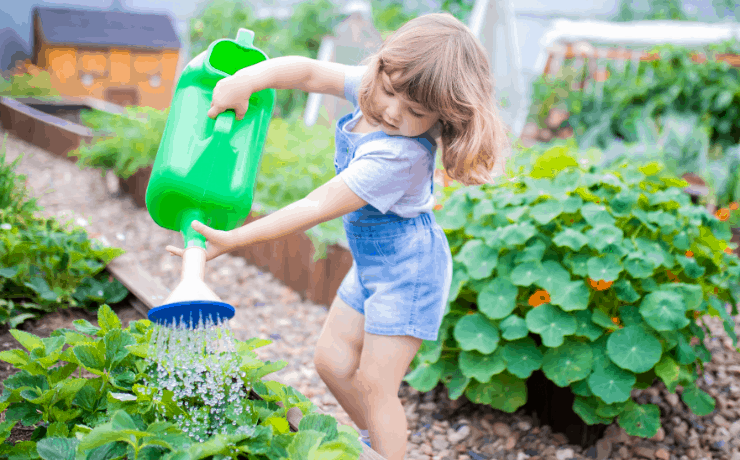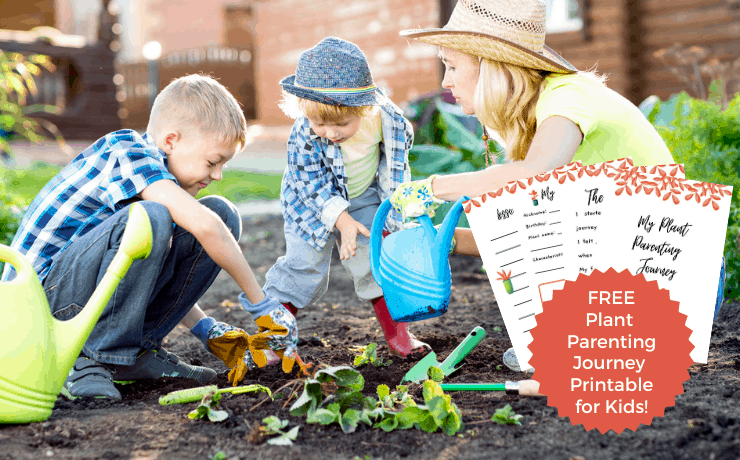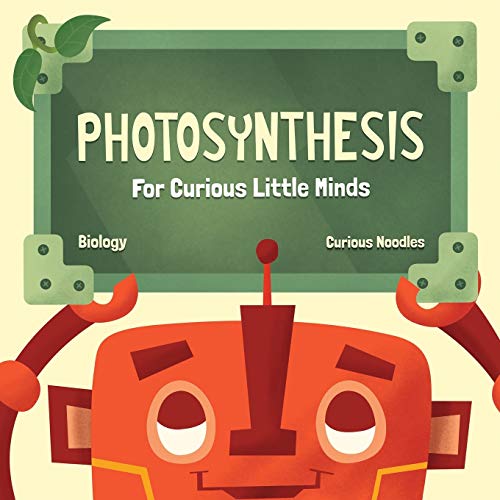Seeking some helpful information on growing plants for kids? We have lots of tips and advice to offer here, as well as a FREE plant journey printable pack!
Before you start helping your children grow plants, you want to get them interested in the hobby of gardening.
Read age-appropriate books. Show them pictures of beautiful gardens online. Purchase gardening tools that are just right for them – we reviewed a list of gardening tool sets. And make it as relaxed and fun as possible 😊
Growing Plants for Kids – Helpful Ideas
We also have a fun Plant Parenting Journey printable pack at the bottom of this post. Make sure to grab it to help your kids to document their process. This activity is GREAT for homeschoolers or any kids that are brand new to gardening and taking care of plants.
It’s also important that kids know what plants need to grow. They have to learn what plants need, as well as how often and how much of each basic need to give their crops. The amount will vary based on the plants you choose, but growing plants for kids comes down to 5 basic needs.

What Do Plants Need to Grow?
Plants have 5 basic needs. All of these needs can be remembered in the acronym “LAWNS” which can make it easier for kids to recall. This acronym came from BigGreen.org in their plant needs lesson for young kids.
Here’s what each letter of LAWNS stands for:
- L – Light
- A – Air
- W – Water
- N – Nutrients
- S – Space
Light
Plants need sunlight and the heat that comes from the sun to grow and thrive, just like humans need warmth. The temperature matters as well, which is why some plants will only grow at certain times of the year.
Some plants need the summer light and heat, while others are better suited for cooler seasons. This concept can be a great introduction to photosynthesis!
Photosynthesis: For Curious Little Minds (Biology)Photosynthesis (Beginning Science: Ecology)Photosynthesis: Changing Sunlight into Food (Nature’s Changes)
Air
Just like humans must have oxygen to breathe and live, plants need carbon dioxide for energy. This factor is another part of photosynthesis.
Water
Water is a necessary part of plant lives in many ways, just as it is for humans. For plants, water helps move nutrients throughout the different parts, including from the soil through the roots out to each petal and leaf.
Water is also important for photosynthesis. It helps keep your crops from wilting in the warm weather.
Nutrients
Plants need a number of nutrients to grow and thrive properly. They take some of these nutrients from the sunlight and water, and others from the soil they’re planted in. These nutrients include nitrogen, potassium, phosphorus, calcium, and magnesium.
Space
Every plant needs room to grow. Some plants roots take up more room than others, so it’s important you know about the plants you are growing.
Make sure there is sufficient space for the roots, stems, and leaves to grow. Crowded plants will struggle as they fight for their basic needs of sunlight and air.

Choosing the Right Plants for Kids to Grow
Kids will be most excited about gardening when they can choose which plants to grow. However, it’s also important that you steer them in the right direction of which plants to choose based on the following factors:
1. Germinate Quickly
You want to choose plants that will germinate quickly – meaning the seed will turn into a sprout and shoot up from the soil fast. Some plants are slow at this process – and that may cause your children to lose interest. When your kids are just beginning with gardening, choosing plants with a quick germination rate will keep their attention spans.
Bonus Tip! Your children can help speed up the process of germination by using scarification. This step is an easy process of lightly scrubbing the seeds with sandpaper, then placing them in a jar of water the night before planting. It helps with water absorption and speeds the process of the sprout forming.
2. Produce a Crop Quickly
Not only do the kids want to see sprouts coming from the dirt, they want to see the end product as soon as possible. Whether it’s a flower or a vegetable, choose seedlings that will soon give your children the reward they’re working for.
3. Very Low Maintenance
When starting out, your children need to be responsible for plants that only require watering and feeding. You want to start them off small and you can work your way up to more high-maintenance plants as your children get older and want the challenge.
You will also find it helpful to read books with your kids about gardening and growing plants. Your kids will better understand the process and what to expect. A few books that we’ve found helpful include:
Gardening Lab for Kids: 52 Fun Experiments to Learn, Grow, Harvest, Make, Play, and Enjoy Your Garden (Volume 24) (Lab for Kids, 24)From Seed to PlantHello, World! Garden TimeLet’s Get GardeningUp in the Garden and Down in the Dirt: (Nature Book for Kids, Gardening and Vegetable Planting, Outdoor Nature Book) (Over and Under)Plant It! Grow It, Eat It

6 Easy Plants for Kids to Grow
The following are several crops that we recommend you and your children start with when growing plants for kids. These crops are all low maintenance and will be germinating within days of being planted. They’ll also produce a crop quickly so your kids can see the fruits of their labor and be proud of their plants 🌱
1. Radishes
Radishes are among the fastest growing crops, making them perfect for a beginner’s garden. They need a large amount of water in the beginning.
Your kids will see the radishes sprouting from the soil within 6-8 days. Many students have successfully used growing radishes for science projects since they germinate so quickly.
2. Snap Peas
Germination of snap peas only takes 10 days. Kids will be excited to see them popping up from the soil.
The peas will be ready to eat in less than 2 months. Picking the snap peas from their stems is fun for kids, too.
3. Pumpkins
Pumpkin seeds are very easy to grow. Kids can save them from their Halloween jack-o-lanterns, making it a fun connection to the holiday and real world. Pumpkin seeds will germinate quickly, in about 6 to 10 days.
My boys and I have had a blast growing pumpkin seeds from store-bought pumpkins. One year, we were able to harvest over 30 pumpkins from the seeds of just one pumpkin!

4. Watermelons
Melons germinate within 5 to 10 days, making them a great choice when growing plants for kids. Plus, they’re tasty treat once they are ready! Other melons, like honeydew and cantaloupe, are good choices, too.
5. Sunflowers
Sunflowers are a favorite for many kids that like to garden. Their seeds tend to start sprouting within a week of being planted. Plus it’s fun to watch them grow tall. Most sunflowers will be taller than your children by the time they’re done growing.
6. Zinnias
Another pretty flower that is great when growing plants for kids is the zinnia. They don’t require much and their seeds start to geminate within 5 to 7 days.
Zinnias are a great pick for kids because they come in several different colors. Kids can have fun learning about each zinnia variety and deciding which ones to plant.
FREE Printable Pack: My Plant Parenting Journey
Your children can document the process of growing their own plants with this fun printable My Plan Parenting Journey pack.
This 12-page gardening activity pack includes a pages about the gardener, how they felt when they started gardening, and a page for each plant baby. Perfect for homeschool writing, summer fun activities, and extracurricular fun!
As their fruits, vegetables, or flowers grow, kids can record how they took care of them, how often they water them, and their overall experience. This type of writing activity would be a fun to do each season, recording different plants and how each required their own caring methods.

Have you tried growing plants with kids? How did your experiences work? And what tips would you add? Please share in the comments area at the bottom of the post 😊











